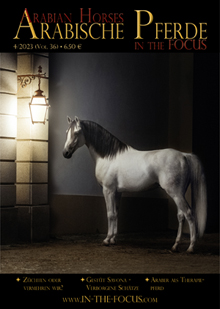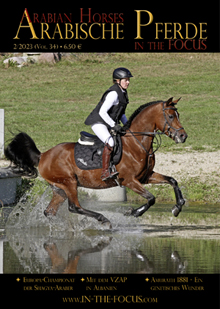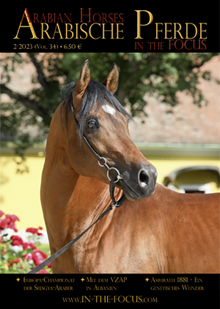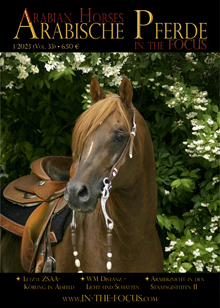Almost 12 years ago (!), I have written the following article for the ARABER JOURNAL magazine (no. 2/2006). It is frightening, that we still have the very same problems!!
For too many years, the Arabian horse was mainly promoted as a show horse. But with declining numbers in shows some people woke up. However, changing the image of the Arabian horse is going to cost some money!
 Do you occasionally wonder why shows have become such an important part of the Arabian horse scene, and actually took the space occupied in other horse breeds by the various sports disciplines? The reasons are complex, but let’s try to analyse them.
Do you occasionally wonder why shows have become such an important part of the Arabian horse scene, and actually took the space occupied in other horse breeds by the various sports disciplines? The reasons are complex, but let’s try to analyse them.
The Four Reasons
1. Shows have their origin in breed or stock shows, i.e. the evaluation of breeding animals, and as such, the breeders who are the members of the breed associations are the ones who exhibit at shows. For this reason, there is a firm link between breeders, breed associations, and shows. Breed associations do what their members ask them to do. If the breeders’ interests are in shows, they will promote the shows.
2. You can start showing with a yearling, or even with a foal, thus you get an assessment and an idea whether or not your product is a “success” quite early in the horse’s life, which is helpful for future breeding decisions.
3. Showing doesn’t require a lot of preparation (compared to sports); even if done seriously, a preparation time of 3 – 4 months is enough to train and condition a horse for a major international show.
4. Shows have developed a life of their own, they have achieved their own right to exist, as they create the same suspense, excitement, competition, success, recognition, etc, that others may find in a sports competition. And so, over the years shows have completely filled the space where sports classes prevail in other breeds.
This development has become a spiral, going up at first, during the heydays of the shows in the 1980ies and 90ies when there was a sufficiently big market for breeding horses and the sole purpose of the Arabian horse was to be shown and to breed on. Then the market of those who would buy a horse for breeding and showing purposes was saturated, but the production was still going on. New markets would have been needed, but in the meantime, the market for leisure time and versatile sports horses was occupied by other breeds, and the Arabian breed associations had missed the opportunity to establish the Arabian horse as a versatile riding horse for everybody. This, together with the fact that Arabian horse breeders were seldom active riders themselves, led to a separation of breeders as “producers” and riders as “users”, to the extent that the first ones do not know about the needs of the latter ones.
The Gap
Even if the following picture is generalised, it does bear some truth: For most breeders, breeding Arabian horses is a hobby, not a profession or source of income. It is an expensive hobby, where they enjoy the excitement whether the hours of studying pedigrees and selecting breeding stallions have finally paid off in producing a foal that comes up to their expectations. They find pleasure in experiencing a foal being born, doing its first steps, growing at the side of its mother and later playing in the fields.
Riders, on the other hand, enjoy grooming, riding and competing with their horse, they enjoy hacking out with them in nature, the company of others with the same interest and the physical exercise this sport provides.
Breeders find it an additional financial burden on their shoulders to have their young horses broken to saddle and trained, while riders, often young people without much money, are not prepared to pay that higher price.
The link between the two groups is missing. In other breeds, where success in riding competitions is used as a promotion tool by breeders, this link exists. Attempts have been made to bring the two together: Shows and sports, breeders and riders. It works in some countries, such as Great Britain, where, traditionally, the rift hasn’t been so deep, but it doesn’t work in most countries: If you go to Aachen, you’ll find thousands of spectators watching the show, but only a handful of grooms and family members of the riders to watch the sports classes.
The False Image
Even if we understand how it happened that shows have become the one and only “brand name” of the Arabian horse, it doesn’t mean that it should remain this way. Declining numbers in show entries demonstrate that something needs to be done for the Arabian horse to survive in direct competition with all the other breeds. Therefore, schemes are needed to get breeders interested in their horses competing in sports classes, and riders must become interested in participating in breed competitions. How to achieve this?
Some ideas to help the breeders are: To give price money for riding competitions of which a certain percentage is paid as breeders’ premium. To collect the sport results in a database, for the breeders to get an idea where certain performance bloodlines can be found and to indicate successful performance horses or sires/dams of performance horses.
In order to help the riders, the breed competitions need to be attractive and of comparative or better standard than the open competitions. As the frequency will never be as high as that of open competitions, transportation subsidies might be an additional idea, as is refunding entry fees by the breed association, if the competition has been successfully completed.
But the problem with all these ideas is easily to be pinned down: Money. Any of these promotional tools will cost money, which is rare these days. However, money which is spent in public relations and promotion seems to pay off, if you think about the successful promotion of Quarter Horses: In any country where Western Riding is being promoted, the market is soon almost completely occupied by Quarter Horses and this is not only because they are more suitable for the sport! Therefore, breed associations and their members need to understand that supporting the riders indirectly helps themselves to market their horses. Even if these riders are not a member of the breed associations, the horses are the products of the members. Secondly, any money that goes into the sport is not wasted, but should actually be labelled as “public relations” or “promotional” money, as the riders promote the usability of the Arabian Horse and that is what the general market is looking for. Like with all public relations, it does not pay off immediately, and not necessarily directly back to the point where it came from. However, if done the right way, it pays off on a long-term basis. But it takes farsightedness. Let’s hope for it for the New Year.
Gudrun Waiditschka












